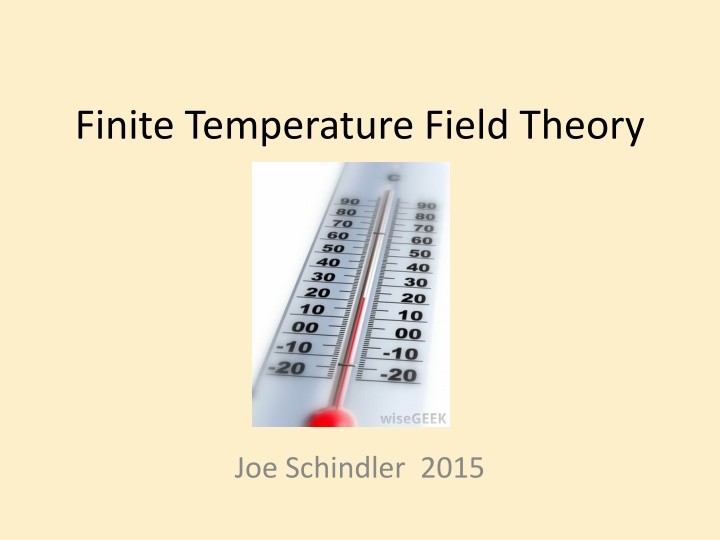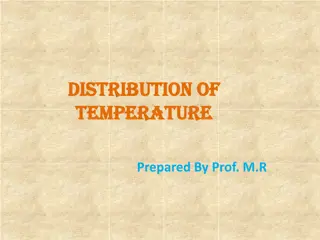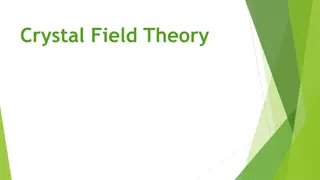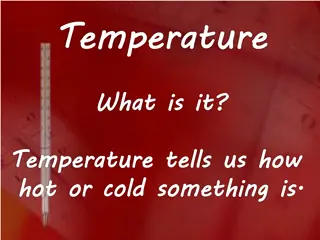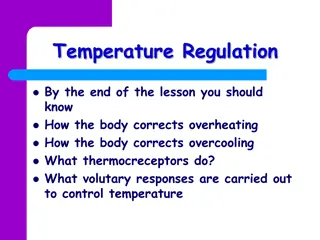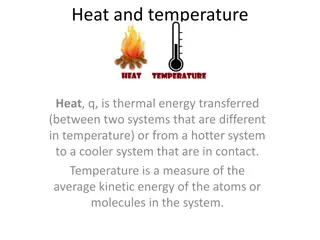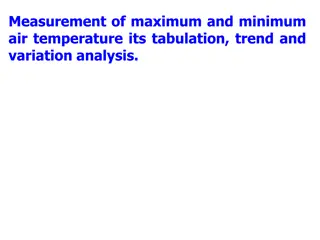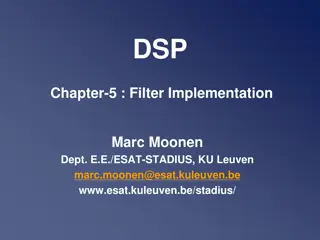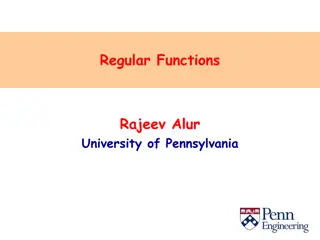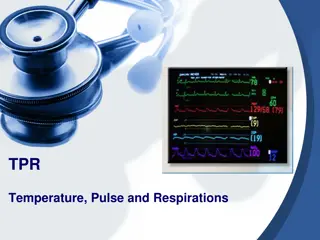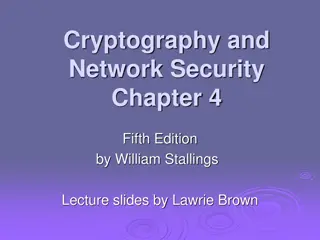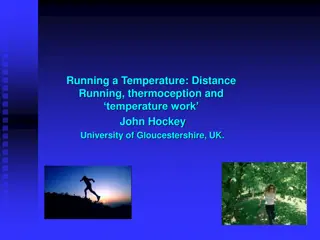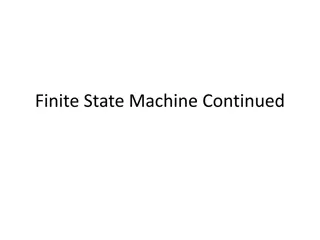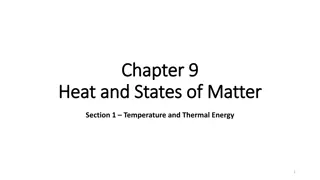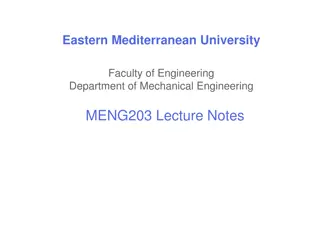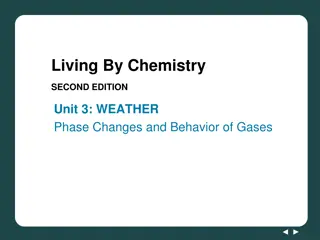Finite Temperature Field Theory Basic
Delve into the realm of finite temperature field theory through a comprehensive exploration of basic methods, including generating functional for Green functions, partition function in equilibrium, path integral representation, and thermal Green functions. Discover the nuances of real-time and imaginary-time thermal Green functions, and their implications for systems away from equilibrium and equilibrium calculations.
Download Presentation

Please find below an Image/Link to download the presentation.
The content on the website is provided AS IS for your information and personal use only. It may not be sold, licensed, or shared on other websites without obtaining consent from the author.If you encounter any issues during the download, it is possible that the publisher has removed the file from their server.
You are allowed to download the files provided on this website for personal or commercial use, subject to the condition that they are used lawfully. All files are the property of their respective owners.
The content on the website is provided AS IS for your information and personal use only. It may not be sold, licensed, or shared on other websites without obtaining consent from the author.
E N D
Presentation Transcript
Finite Temperature Field Theory Joe Schindler 2015
Part 1: Basic Finite Temp Methods
Preview Zero Temp Finite Temp Green Functions (vacuum expectation value) Generating Functional for GFs (real time)
Preview Zero Temp Finite Temp Green Functions Green Functions (vacuum expectation value) (ensemble averaged expectation) Generating Functional for GFs Generating Functional for GFs (imaginary time GFs) (real time) (complex time GFs)
Preview Zero Temp Finite Temp Green Functions Green Functions (vacuum expectation value) (ensemble averaged expectation) Generating Functional for GFs Generating Functional for GFs (imaginary time GFs) (real time) (complex time GFs) Not scattering amplitudes Used more like `correlation fns in the stat mech sense. S-matrix and Scattering Amplitudes (from the GFs)
Preview Zero Temp Finite Temp In equilibrium Partition Function (canonical ensemble) (grand canonical) Ensemble Average Can calculate all thermodynamic quantities from partition function.
Preview Zero Temp Finite Temp Package deal when using Z[B,J]
Partition Function (Canonical Ensemble) Path Integral Representation Use perturbation theory and feynman diagrams to evaluate in interacting case, exactly like zero temp. How many loops? Derive path integral rep with the identity for transition amplitudes:
Thermal Green Functions ``Real Time Thermal Green Functions Generated by - Can give time evolution of finite temp system away from equilibrium. - Not necessary to assess equilibrium properties. - Reduce to our old GFs at zero temp limit:
Thermal Green Functions Imaginary Time Thermal Green Functions Generated by - Special case of previous version, more practical for equilibrium calcs.
Thermal Green Functions Imaginary Time Thermal Green Functions Generated by Very simple, and also gives partition function. - Special case of previous version, more practical for equilibrium calcs.
Field Thermodynamics Example For a free boson field at thermal equilibrium, calculate energy spectrum.
Field Thermodynamics Example For a free boson field at thermal equilibrium, calculate energy spectrum.
Field Thermodynamics Example For a free boson field at thermal equilibrium, calculate energy spectrum.
Field Thermodynamics Example Continuing with same example Evaluate generating functional: where
Field Thermodynamics Example Continuing with same example Evaluate generating functional: where Discrete frequency sum New BCs for inverse eqn Euclidean equivalent of minkowski propagator
Field Thermodynamics Example Adding in Interactions?? Evaluate perturbatively: Now you have partition function including interactions to n loops!!
Field Thermodynamics Example Adding in Interactions?? Evaluate perturbatively: Now you have partition function including interactions to n loops!! -Same feynman diagram expansion as zero temp except: - euclidean propagator - finite tau integral / discrete frequency sum - (for real-time formalism) thermal ghost fields
Field Thermodynamics Example Generators and Free energies: Partition Fn Connected Functional / Helmholtz or Gibbs FE Effective Potential Equilibrium Condition
Part 2: Symmetry Breaking Phase Transitions
SSB at Finite Temp Definition (SSB at Thermal Equilibrium): A symmetry of the lagrangian is spontaneously broken when the ensemble average of the field multiplet doesn t respect the symmetry. Typically accompanies a 2nd order phase transition (e.g. discontinuous heat capacity)
SSB at Finite Temp How to analyze it? - Expect it if there is a zero-temp VEV . - In principle: Calculate finite temperature quantum effective action and apply equilibrium condition. -In practice: Becomes a simple application of thermodynamics at tree level. Add quantum corrections by summing loop diagrams in partition function. 1. Expand lagrangian around the ensemble average value . 2. (here s where quantum corrections come in) Calculate partition function Z( , ). 2. (this is just free energy written as a function of ) (check: ought to obey (T=0,x) = V(x)) Find thermodynamic effective potential ( , ) 4. Minimize effective potential wrt .
SSB Example Complex scalar with sombrero potential: Expand about ensemble avg: Potential becomes: (*cheat and ignore linear term it can be justified, see Kapusta could avoid but we re doing simplest possible way)
SSB Example So interesting terms are: Now everything is a function of (and thus also of T): Including partition fn! Technique of making Z depend on average value is ``mean field method. To lowest approximation (noninteracting quasiparticles), the partition function factors into two noninteracting free boson field contributions. ( this is zeroth order mean field approximation, next would be tree level mean field) Where those euclidean lagrangians are free:
SSB Example But we already found ln(Z) for free massive boson fields! Thus the thermodynamic effective potential is For temperatures can expand (see Kapusta):
SSB Example Thermodynamic potential : It s a Landau phase transition problem! As T increases, symmetry breaking minimum disappears. SSB occurs when So critical temperature is Noting that (Kapusta, pg.121)
SSB Example At various temperatures, it acts to first approximation like two noninteracting ideal boson gases. The quasiparticle masses depend on temperature. Spontaneous symmetry breaking occurs below a critical temperature.
Spontaneously broken gauge theories??? (I googled confused monkey ) Same analysis applies.
Electroweak Symmetry Restoration Restored at Tc~250GeV (see lit) Easily estimated from Higgs potential graph.
